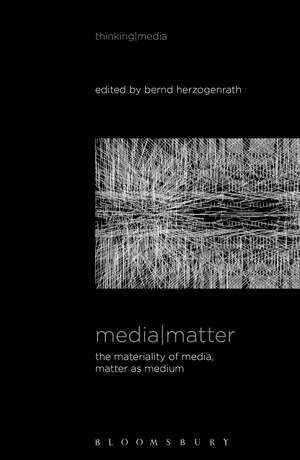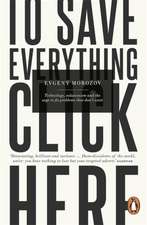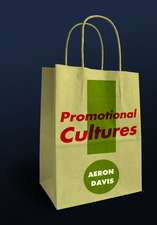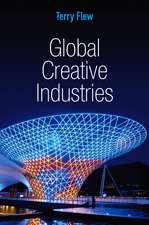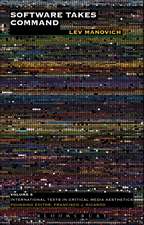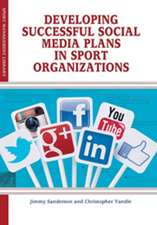Media Matter: The Materiality of Media, Matter as Medium: Thinking Media
Editat de Professor Bernd Herzogenrathen Limba Engleză Hardback – 26 aug 2015
| Toate formatele și edițiile | Preț | Express |
|---|---|---|
| Paperback (1) | 257.76 lei 6-8 săpt. | |
| Bloomsbury Publishing – 22 feb 2017 | 257.76 lei 6-8 săpt. | |
| Hardback (1) | 833.06 lei 6-8 săpt. | |
| Bloomsbury Publishing – 26 aug 2015 | 833.06 lei 6-8 săpt. |
Din seria Thinking Media
- 23%
 Preț: 198.93 lei
Preț: 198.93 lei - 23%
 Preț: 193.62 lei
Preț: 193.62 lei - 30%
 Preț: 537.78 lei
Preț: 537.78 lei - 30%
 Preț: 538.77 lei
Preț: 538.77 lei - 22%
 Preț: 258.33 lei
Preț: 258.33 lei - 13%
 Preț: 257.76 lei
Preț: 257.76 lei - 22%
 Preț: 239.59 lei
Preț: 239.59 lei - 14%
 Preț: 183.70 lei
Preț: 183.70 lei -
![Eigenvalue: On the Gradual Contraction of Media in Movement; Contemplating Media in Art [Sound Image Sense]](https://i2.books-express.ro/bs/9781501363177/eigenvalue.jpg) Preț: 222.84 lei
Preț: 222.84 lei - 22%
 Preț: 226.97 lei
Preț: 226.97 lei - 21%
 Preț: 215.88 lei
Preț: 215.88 lei - 24%
 Preț: 196.08 lei
Preț: 196.08 lei - 24%
 Preț: 196.36 lei
Preț: 196.36 lei - 24%
 Preț: 195.03 lei
Preț: 195.03 lei - 23%
 Preț: 199.91 lei
Preț: 199.91 lei - 24%
 Preț: 189.87 lei
Preț: 189.87 lei - 23%
 Preț: 192.55 lei
Preț: 192.55 lei - 23%
 Preț: 191.67 lei
Preț: 191.67 lei - 23%
 Preț: 193.87 lei
Preț: 193.87 lei - 30%
 Preț: 537.37 lei
Preț: 537.37 lei
Preț: 833.06 lei
Preț vechi: 1066.30 lei
-22% Nou
Puncte Express: 1250
Preț estimativ în valută:
159.40€ • 166.43$ • 131.93£
159.40€ • 166.43$ • 131.93£
Carte tipărită la comandă
Livrare economică 04-18 aprilie
Preluare comenzi: 021 569.72.76
Specificații
ISBN-13: 9781628923834
ISBN-10: 1628923830
Pagini: 328
Ilustrații: 20 bw illus
Dimensiuni: 140 x 216 x 23 mm
Greutate: 0.57 kg
Editura: Bloomsbury Publishing
Colecția Bloomsbury Academic
Seria Thinking Media
Locul publicării:New York, United States
ISBN-10: 1628923830
Pagini: 328
Ilustrații: 20 bw illus
Dimensiuni: 140 x 216 x 23 mm
Greutate: 0.57 kg
Editura: Bloomsbury Publishing
Colecția Bloomsbury Academic
Seria Thinking Media
Locul publicării:New York, United States
Caracteristici
An overview of an innovative and very specific media-philosophical approach in action - an exciting research field in-the-making
Notă biografică
Bernd Herzogenrath is Professor of American Studies at the University of Frankfurt, Germany.
Cuprins
Media Matter: An IntroductionBernd Herzogenrath (Goethe-University Frankfurt, Germany)Theory-MatterChapter 1: The Meta-Physics of MediaWalter Seitter (University of Applied Arts Vienna, Austria)Chapter 2: Media Matter: Materiality and Performativity in Media TheoryKaterina Krtilova (Bauhaus-Universität Weimar, Germany)Text-MatterChapter 3: Between Print Matter and Page Matter: The Codex Platform as Media SuppoortGarrett Stewart (University of Iowa, USA)Chapter 4: 'Local Color': Light in Faulkner Hanjo Berressem (University of Cologne, Germany)Film-MatterChapter 5: Figure-Ground: Stills from the Films of Bill Morrison Bill Morrison (Hypnotic Pictures)Chapter 6: Matter that Images: Bill Morrison's DecasiaBernd Herzogenrath (Goethe-University Frankfurt, Germany)Chapter 7: Moving Images as Ontographic ImagesLorenz Engell (Bauhaus-Universität Weimar, Germany)Chapter 8: Brain Matter and New Phrenologies; Challenging Brains with Melancholy and Vice VersaBenjamin Betka (Goethe-University Frankfurt, Germany)Chapter 9: The Media Boundary Objects Concept: Theorizing Film and Media Florian Hoof (Goethe-University Frankfurt, Germany)Art-MatterChapter 10: Borderline: Nauman's Balls and Acconci's ShootEva Ehninger (University of Bern, Switzerland)Chapter 11: The Romantic Readymade: Towards a Material Vitalism of Contemporary ArtStephen Zepke (University of Applied Arts Vienna, Austria)Sound-MatterChapter 12: Revisiting the Voice in Media and as Medium: New Materialist PropositionsMilla Tiainen (University of Helsinki, Finland)Chapter 13: Sonic Matter: The Material Cut-Ups of Christian MarclaySebastian Scherer (Goethe-University Frankfurt, Germany)Chapter 14: Media Disenchantments Thomas Köner (Composer, Sound-Artist, Belgrade, Serbia, and Nice, France)
Recenzii
media|matter continues the important work on materiality of media. The chapters offer inspiring and rich analyses into how voice and sound, film and text open up to realities unthought of. The book is an important addition to the growing body of work on new materialism and is of interest to sound, film and media studies students and scholars.
Media and communications' role in the world has been a dominant area of research-perhaps the dominant area of research-for the past hundred years. Yet strangely, the material world itself has often seemed absent, except as relegated to a support for technical or social developments. Now, however, things are changing. Existing concepts of the importance and nature of the material world are being questioned in the harsh light of uncertain futures. With this, the very concept of media is morphing into something new. Media|Matter takes up the dramatic challenges this poses to some of the central assumptions of media studies. Bernd Herzogenrath has brought together a wonderful collection of essays that document the move beyond the cultural, discursive and even changing technical limits of media studies. Media are rethought in relation to the very materiality of the world. Media|Matter thus wonderfully reassesses the status and condition of media studies in order to take it into the problematic (in both the material and conceptual senses) future that the world now faces. Media|Matter also challenges media disciplinarities in favour of the much fuller and now necessary transdisciplinarity to which media studies has long aspired. All kinds of image are thought again in the light of the material world (as in Bill Morrison, Herzogenrath, Lorenz Engell, Florian Hoof and Eva Ehninger), as are traditional and 3D printing (Garrett Stewart). Questions of performativity (Katerina Krtilova), or a material semiotics, are presented, along with a rethinking of the brain as material medium in the midst of both affects and objects (Benjamin Betka). The materialities of voice (Milla Tiainen) and music (Sebastian Scherer), along with key philosophy debates in art, for example between accelerationism and new materialism (Stephen Zepke). Reading media|matter is like being splashed in the face with cold water and looking up to see the world anew
In recent years the concept of medium (and with it the whole field of media studies) has been repeatedly redefined, particularly by scholars in the German-speaking countries. Media|Matter is an original and important contribution to that process of redefinition. Contributors to this anthology address a range of media forms and practices, including print, film, video and performance art, and sonic art. They apply and often critique a range of theoretical approaches, including media philosophy, systems theory, actor-network theory, feminist theory, the work of Deleuze and Guattari, the art theory of Kraus and Foster, and more. Their varied contributions share a foundational concern with the question of the materiality of media: each essay seeks within its domain to explore the form and matter of contemporary media without resorting to either technological or cultural determinism. Everyone interested in the current condition and the future of media studies should read Media|Matter.
The non-existence of media - as an essential or arche-logical category - clearly creates a vacuum that demands to be filled, in this instance with an almost kaleidoscopic variety of investigations, addressing media materiality in text, film, art, sound , and meta/physics. Beyond simply registering an obligatory 'turn' in media studies, the contributors demonstrate what is to be gained in the fundamental re-thinking of mediation from which media|materiality proceeds.
Media and communications' role in the world has been a dominant area of research-perhaps the dominant area of research-for the past hundred years. Yet strangely, the material world itself has often seemed absent, except as relegated to a support for technical or social developments. Now, however, things are changing. Existing concepts of the importance and nature of the material world are being questioned in the harsh light of uncertain futures. With this, the very concept of media is morphing into something new. Media|Matter takes up the dramatic challenges this poses to some of the central assumptions of media studies. Bernd Herzogenrath has brought together a wonderful collection of essays that document the move beyond the cultural, discursive and even changing technical limits of media studies. Media are rethought in relation to the very materiality of the world. Media|Matter thus wonderfully reassesses the status and condition of media studies in order to take it into the problematic (in both the material and conceptual senses) future that the world now faces. Media|Matter also challenges media disciplinarities in favour of the much fuller and now necessary transdisciplinarity to which media studies has long aspired. All kinds of image are thought again in the light of the material world (as in Bill Morrison, Herzogenrath, Lorenz Engell, Florian Hoof and Eva Ehninger), as are traditional and 3D printing (Garrett Stewart). Questions of performativity (Katerina Krtilova), or a material semiotics, are presented, along with a rethinking of the brain as material medium in the midst of both affects and objects (Benjamin Betka). The materialities of voice (Milla Tiainen) and music (Sebastian Scherer), along with key philosophy debates in art, for example between accelerationism and new materialism (Stephen Zepke). Reading media|matter is like being splashed in the face with cold water and looking up to see the world anew
In recent years the concept of medium (and with it the whole field of media studies) has been repeatedly redefined, particularly by scholars in the German-speaking countries. Media|Matter is an original and important contribution to that process of redefinition. Contributors to this anthology address a range of media forms and practices, including print, film, video and performance art, and sonic art. They apply and often critique a range of theoretical approaches, including media philosophy, systems theory, actor-network theory, feminist theory, the work of Deleuze and Guattari, the art theory of Kraus and Foster, and more. Their varied contributions share a foundational concern with the question of the materiality of media: each essay seeks within its domain to explore the form and matter of contemporary media without resorting to either technological or cultural determinism. Everyone interested in the current condition and the future of media studies should read Media|Matter.
The non-existence of media - as an essential or arche-logical category - clearly creates a vacuum that demands to be filled, in this instance with an almost kaleidoscopic variety of investigations, addressing media materiality in text, film, art, sound , and meta/physics. Beyond simply registering an obligatory 'turn' in media studies, the contributors demonstrate what is to be gained in the fundamental re-thinking of mediation from which media|materiality proceeds.
